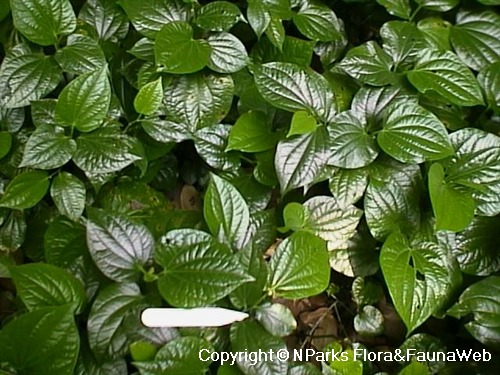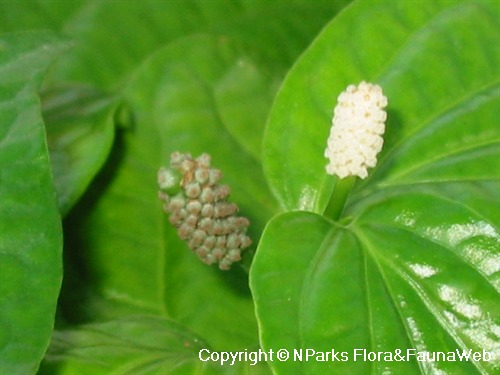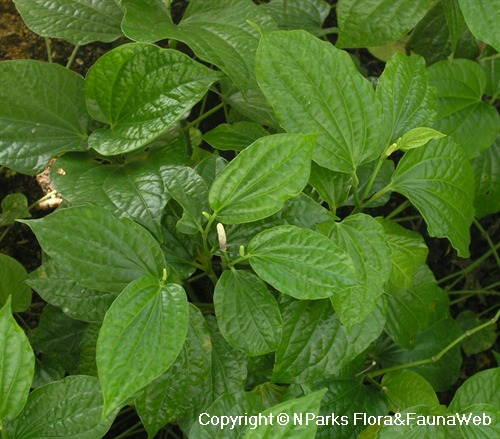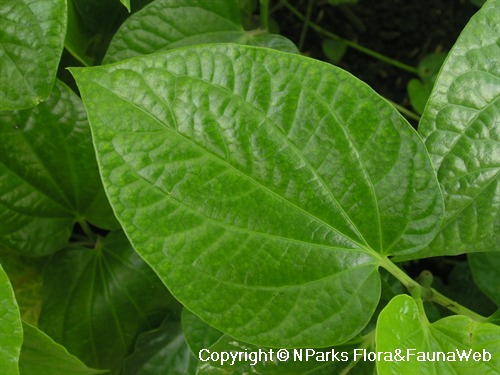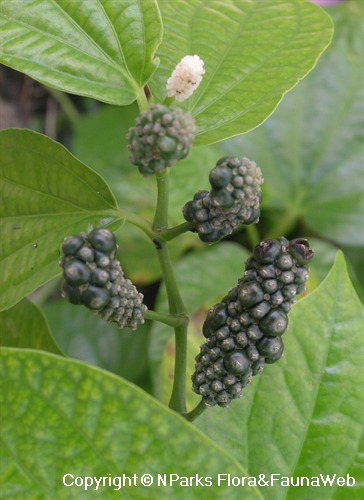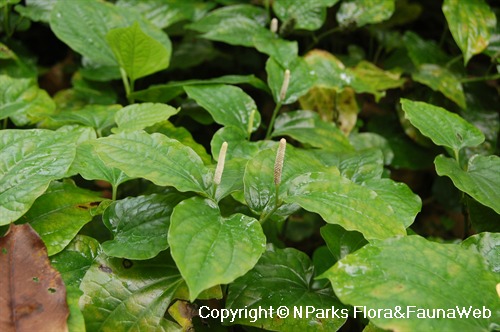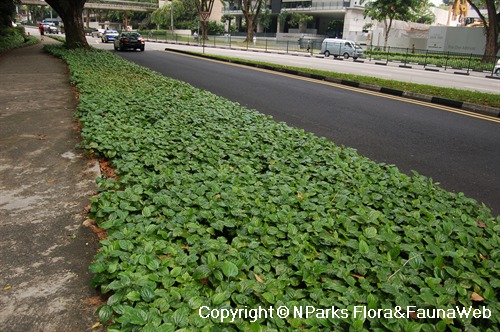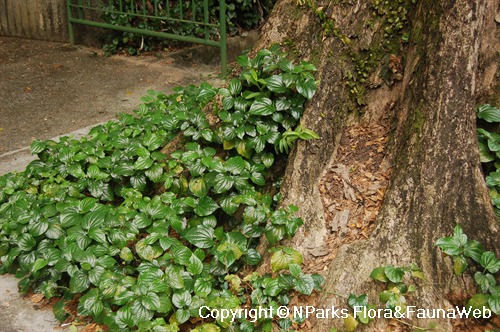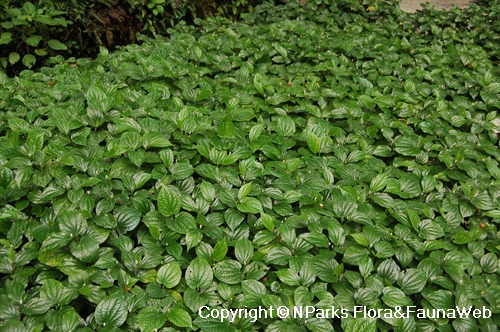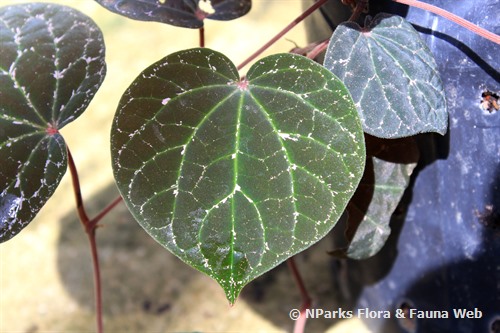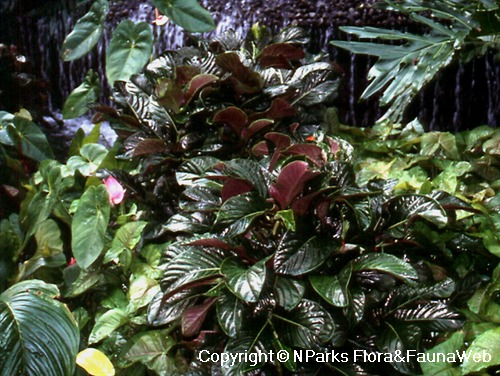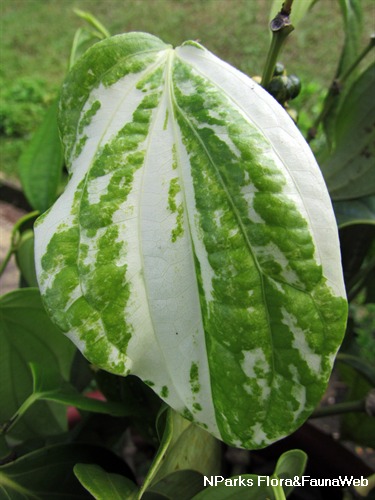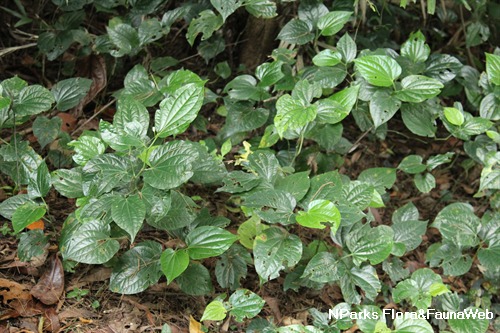
Back
Piper sarmentosum Roxb. ex W.Hunter
| Family Name: | Piperaceae |
| Synonyms: | Chavica sarmentosa, Piper brevicaule |
| Common Name: | Wild Pepper, Wild Betel, Kadok, Kaduk, Daun Kaduk, Chabei, Sri Tanah, Chaa Phluu, La Lot, Akar Bugu, Sirih Duduk, 假蒟, 细叶青萎藤, 青蒟 |
Name
Classifications and Characteristics
| Plant Division | Angiosperms (Flowering Seed Plants) (Dicotyledon) |
|---|---|
| Plant Growth Form | Creeper |
| Lifespan (in Singapore) | Perennial |
| Mode of Nutrition | Autotrophic |
| Plant Shape | Shrubby |
| Maximum Height | 0.3 m to 0.6 m |
| Maximum Plant Spread / Crown Width | 0.3 m |
Biogeography
| Native Distribution | Southern China, India, Indochina, Malaysia, Indonesia, Philippines |
|---|---|
| Native Habitat | Terrestrial (Secondary Rainforest, Monsoon Forest, Primary Rainforest) |
| Preferred Climate Zone | Tropical, Sub-Tropical / Monsoonal |
| Local Conservation Status | Native to Singapore (Least Concern (LC)) |
Description and Ethnobotany
| Growth Form | It is a sprawling herbaceous creeper, with erect stems at intervals, growing close to the ground and forming mounds of up to 60 cm in height. The stems are slightly hairy. |
|---|---|
| Foliage | Its alternate, stalked leaves have leaf blades that are heart-shaped, glossy dark green, and 7–15 by 5–13 cm, with 5–7 prominent veins. The leaves emit a pungent peppery scent when crushed. |
| Flowers | Its erect, cylindrical flowering shoots are 1–2 cm long, and consist of small, stalkless and petal-less white male or female flowers. Species is monoecious, where male and female flowers are produced on different spikes on the same plant. The male flower spikes are 6 mm long, while the female flower spikes are longer and denser (12 mm long). |
| Fruit | Its one-seeded fruits are small aggregated nodular drupes formed from female spikes, maturing to deep green. |
| Habitat | It grows in thickets, and forests up to 1,000 m altitude. |
| Ethnobotanical Uses | Edible Plant Parts : Edible Leaves, Edible Flowers, Edible Stems Food (Herb or Spice): Leaves sliced and added into a herb and rice dish called Nasi Ulam or Nasi Kerabu in northern states of Peninsular Malaysia. Dried flower inflorescence used as spice. (Fruit or Vegetable): Young leaves and shoots eaten raw and dipped in sambal as salad. Leaves also used to wrap snacks or used as lining to prepare appetizers like otak-otak (spicy fish paste). Medicinal: Whole plant believed to be medicinal. Leaves boiled in water and taken to treat coughs, flu and malarial fever. Leaves also chewed with betel nut and swallowed as remedy for coughs and asthma. Leaves pounded and used as poultice for headaches. Leaf decoction applied as body rub for body aches. Roots crushed with salt and used to relieve toothache by Chinese and Thais. Plant also taken for diuretic and antioxidant properties. Reported to reduce blood sugar and improve diabetes. Others: The Ambionese mix the plant with tumeric into laundrey water so that the washed clothes would be scented. |
Landscaping Features
| Landscaping | It has attractive glossy dark green leaves. It makes a good border plant or ground cover for shaded to semi-shaded sites. |
|---|---|
| Desirable Plant Features | Ornamental Foliage, Ornamental Fruits, Fragrant (Foliage) |
| Landscape Uses | Container Planting, Interiorscape/ Indoor Plant, General, Flowerbed / Border, Suitable for Roadsides, Parks & Gardens, Small Gardens, Groundcover |
| Thematic Landscaping | Naturalistic Garden |
Fauna, Pollination and Dispersal
| Pollination Method(s) | Biotic (Fauna) |
|---|---|
| Seed or Spore Dispersal | Biotic (Fauna) |
Plant Care and Propagation
| Light Preference | Semi-Shade |
|---|---|
| Water Preference | Lots of Water, Moderate Water |
| Plant Growth Rate | Moderate |
| Rootzone Tolerance | Easy to Grow, Fertile Loamy Soils, Well-Drained Soils, Moist Soils |
| Maintenance Requirements | Low |
| Potential Problems | Older plants may get spindly and leggy with loss of lower leaves. |
| Diseases | May be attacked by grasshoppers. |
| Pest(s) | Associated with, Chewing Insects |
| Propagation Method | Seed, Stem Cutting |
Foliar
| Foliage Retention | Evergreen |
|---|---|
| Mature Foliage Colour(s) | Green |
| Mature Foliage Texture(s) | Smooth, Glossy / Shiny, Raised / Sunken Veins |
| Foliar Type | Simple / Unifoliate |
| Foliar Arrangement Along Stem | Alternate |
| Foliar Attachment to Stem | Petiolate |
| Foliar Shape(s) | Non-Palm Foliage (Cordate) |
| Foliar Venation | Pinnate / Net |
| Foliar Margin | Entire |
| Foliar Apex - Tip | Acuminate |
| Foliar Base | Cordate |
| Typical Foliar Area | Mesophyll ( 45cm2 - 182.25 cm2 ) |
| Leaf Area Index (LAI) for Green Plot Ratio | 4.5 (Shrub & Groundcover - Dicot) |
Non - Foliar and Storage
| Stem Type & Modification | Herbaceous, Runner / Stolon |
|---|---|
| Root Type | Underground (Fibrous Root) |
Floral (Angiosperm)
| Flower & Plant Sexuality | Unisexual Flowers , Monoecious |
| Flower Colour(s) | White |
|---|
| Flower Grouping | Cluster / Inflorescence |
| Flower Location | Terminal |
| Flower Size - Remarks | Male spike (6mm long), Female spike (12mm long) |
| Inflorescence Type | Spike |
| Flowering Period | Free-Flowering |
| Flowering Habit | Polycarpic |
Fruit, Seed and Spore
| Mature Fruit Colour(s) | Green |
|---|---|
| Fruit Classification | Aggregate Fruit (Syncarp) |
| Fruit Type | Fleshy Fruit , Drupe |
Image Repository
Others
| Master ID | 1049 |
|---|---|
| Species ID | 2342 |
| Flora Disclaimer | The information in this website has been compiled from reliable sources, such as reference works on medicinal plants. It is not a substitute for medical advice or treatment and NParks does not purport to provide any medical advice. Readers should always consult his/her physician before using or consuming a plant for medicinal purposes. |

